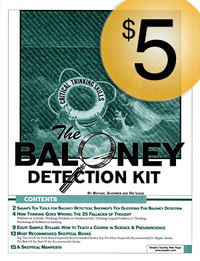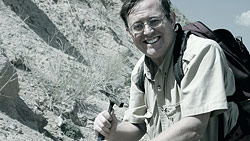- free temporary download: How to Debate a Creationist
- feature article: Turning a Biology Curriculum Upside Down
- MonsterTalk: Horrifying Hybrids
- latest from Michael Shermer: Michael Shermer’s New Blog,
Daniel Loxton joins Skepticblog - upcoming lecture: Evolution, Extinction, and the Future of Our Planet
FREE DOWNLOAD (one week only!)
How to Debate a Creationist
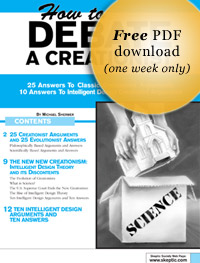
In honor of the 150 anniversary (this month) of Charles Darwin’s The Origin of Species, and in the face of opposition to modern biology, we are pleased to offer one of our top selling resources as a free PDF download for one week only.
This 22-page handout edition includes: 25 evolutionist answers to 25 creationist arguments, and 10 answers to Intelligent Design creationist arguments.
DOWNLOAD the FREE
22-page PDF handout edition
ORDER the full 27-page printed booklet for only $5 from Shop Skeptic
In this week’s eSkeptic, Clark Lindgren recounts the birth of Bio 150 — An Introduction to Biological Inquiry. By turning the curriculum on its head, the Biology Department at Grinnell College has created opportunities for students to perform actual scientific research from the get-go. Results suggest that students are getting just what they need to confirm their interest in biology and get an early start developing their skills as young scientists.
Clark Lindgren, Ph.D. is Professor of Biology at Grinnell College in Grinnell, Iowa. Professor Lindgren received his doctoral degree from the University of Wisconsin, Madison in Physiology and was a postdoctoral fellow at Duke University in Neurophysiology. He teaches courses in Animal Physiology, Neuroscience, and Introductory Biology and has published numerous research articles on the process of synaptic transmission at the neuromuscular junction.

Teaching by Doing
Turning a Biology Curriculum Upside Down
by Clark Lindgren, Ph.D.
Try to imagine the following scenario. Tommy always wanted to be a professional tuba player. He didn’t have many opportunities to do serious tuba playing in high school so was thrilled when a college with a “world renowned” tuba program accepted him. He couldn’t wait to begin. Unfortunately, tuba school wasn’t quite what Tommy had imagined. His first class, Tuba 101, was held in a large lecture room with over 100 students and dutifully reviewed the history of the tuba. Tuba 102 the following semester focused on the theory of the tuba. Although these large Intro classes had weekly “labs” that were much more practical than the lectures, Tommy didn’t actually play the tuba at all during his first year. He got to experiment with the mouthpiece once and had a few great labs exploring the valves (he even learned how to make one); however, that was as close as he got to the real thing. His second and third years were better. The classes were smaller and the lab exercises more realistic, but it wasn’t until his senior year that he finally had the necessary prerequisites to sign up for Tuba 395: Independent Study. This is what he had come to college for. He would be given a tuba for the entire semester and allowed to play some music that his instructor was working on.
Tell me and I will forget, show me
and I will remember,
involve me and
I will understand!
At this point there are several directions this scenario might go. Tommy might have a great time in his independent study, go off to Tuba graduate school and become the professional tuba player he had long dreamed of becoming. Alternatively, Tommy might have discovered in Tuba 395 that he really wasn’t very good at playing the tuba or, worse yet, he didn’t enjoy playing it as much as he thought he would. Regardless of the direction Tommy’s tuba career takes, all of the scenarios are absurd. Who would defend a curriculum that asks students to wait until their senior year in college to actually do what they came to do? How many college students have the patience or insight to put up with this? How many potentially great tuba players would we lose using this strategy?
Yes, the scenario is absurd and fortunately for the world of tuba players, this is not how most people become professional tuba players. However, anyone who has been a science major in college will recognize the “tuba curriculum.” We pack students into large lecture halls and teach them about science. Yes, we talk about how science is done, especially in the second and third years of our curricula. We teach labs in which students are taught parts of the process. They learn techniques and are asked to make careful measurements and/or observations, but only rarely are students involved in an actual scientific study — that is, an inquiry in which the answer is not known by anyone (including the instructor). The opportunity for students to actually do real science is reserved for much later in the curriculum and, many times, this is reserved for a subset of students who demonstrate exceptional promise for science (i.e. they passed their courses with high marks).
Several years ago my colleagues and I in the Biology Department at Grinnell College began worrying about our own “tuba curriculum.” Even though we were a small private liberal arts college, we were still introducing our students to biology the way it had been done at most colleges and universities for decades. Students were first paraded through a multi-course introductory sequence in which we passed on to them the biology canon. Only then could they take courses that more closely approximated real science. Much to our dismay, this delay was becoming longer and longer. Over the previous ten years, our introduction to biology had grown from two, to three, and then to a four-course sequence as we, along with every other Biology Department in the world, had been trying to accommodate the dizzying growth in biological knowledge. Yet, even with four courses that extended through their second year of college, we were still feeling hard pressed to give our students a complete introduction to biology. Somehow, five “Intro” courses just seemed too much. In the context of this deep curricular soul-searching, we began to entertain a very novel idea. What if we turned our curriculum upside down? What if we just bypassed the traditional Intro courses and had students do research, real research, first and then filled them in on the details/big picture later?
Although it seemed strange at first, the more we thought about an upside down curriculum, the more sense it made. First, it would prevent the bad Tommy Tuba scenario where Tommy didn’t discover until his senior year that with regard to real tuba playing he was either inept or apathetic. Students would discover right up front whether their love for biology was genuine and worth pursing further. Second, some students might discover a love for science they didn’t know they had. These are the students who do not thrive in a traditional curriculum, but possess the skills and mettle to be first-class scientists. (How many biographies of famous scientists begin that way?) Finally, this upside down curriculum would be better for the many students who take biology as part of their general education. These are the future lawyers, business leaders and artists who have no intention of becoming scientists but are taking biology to round out their liberal arts experience. We couldn’t imagine an introduction to biology would be more useful to these future leaders than the one we were contemplating.
EDUCATIONAL BOOKLET
This 16-page booklet is designed to hone your critical thinking skills. It includes suggestions on what questions to ask, what traps to avoid, specific examples of how the scientific method is used to test pseudoscience and paranormal claims, a how-to guide for developing a class in critical thinking, and MORE!
With fear and trepidation we began planning a one-semester course called Bio 150: Introduction to Biological Inquiry. Each of us in the department would design a section of Bio 150 that focused on a specific research area. Each section would teach students the bare minimum needed to get started on a real scientific question. The students would be shown how to perform a few techniques, how to search for and read scientific articles, and how to distinguish a good scientific question from a not-so-good question. Finally, working in groups of three (we had previously discovered that three was the magic number for group work), the students would choose a question, design and carry-out experiments to answer the question, and then present their results and an interpretation of their results in formats appropriate for the discipline.
Our first set of Bio 150 sections were announced in the fall of 2000. Students could choose one (and only one) of the following seven sections: “Building an Animal,” “Prairie restoration,” “The Language of Neurons,” “Biological Responses to Stress,” “Emerging and Re-emerging Pathogens,” “The Effects of Climate Change on Organisms,” and “What Does it Mean to be a Plant?” Since then, we have added a few more sections to our repertoire, including “Sex Life of Plants,” “Plant Genetics and the Environment,” “Survivor,” “Cell Fate: Calvin or Hobbes,” “Genes, Drugs and Toxins,” and “Animal Locomotion.”
This year will be the tenth time we have offered Bio 150. Despite some initial reticence to try such a bold curricular experiment, none of us would choose to return to the “old ways.” Why? Because Bio 150 is challenging, interesting and fun — all of the reasons we became biologists in the first place. And, it is working. It is accomplishing just what we had hoped and then some. Students who arrive in Bio 150 gung-ho about biology (i.e. the Tommy Tubas) generally love it. It is just what they needed to confirm their interest and get an early start developing their skills as young scientists. After taking Bio 150, students who want to go on in biology take a more traditional two-course sequence to round out their background and fill in the gaps in their biological knowledge. However, unlike in the past, our students are more sophisticated now. They understand why a Molecular Biologist needs to know something about ecology or why an Evolutionary Biologist must understand some physiology. It is impossible to answer even the narrowest question without help from other subfields in biology, not to mention chemistry, physics and math. Our students now appreciate, if not enjoy, the broader exposure to biology because they understand why it is necessary.
But this isn’t the experience of all of our students. Some simply do not like Bio 150. Although teachers do not usually like it when students do not enjoy their course, the reasons students offer for their displeasure with Bio 150 suggest that even these are “successes.” A few years after we began teaching Bio 150 one of my advisees announced that she didn’t want to continue in biology. She was a good student and had not done poorly in Bio 150; she just didn’t think she liked biology. Had a student reported this to me in the pre Bio 150 era I would have encouraged her to stick it out a little longer. “Maybe you will enjoy the subject matter that comes later in the sequence.”
This was common advice from me since the course content that related most directly to my specialty came at the end of our four-course Intro sequence. However, in this case my response was “tell me why you didn’t like Bio 150.” Her answer was stunning. “I hate the ambiguity in biology! Even when you design the perfect experiment and perform it perfectly, there is still uncertainty. I understand why this is, I just don’t like it.” When I asked her what subjects she liked, her response was immediate. “I love Math! It is precise, defined and unambiguous.” I was speechless. This first year college student with only one course in biology could articulate the epistemological distinction between an experimental science like biology and a field such as mathematics. (I suspect some professional biologists do not understand this as well as she did!) My response to the student was to congratulate her on her insight and wish her well in her mathematics courses. Not surprisingly, she graduated three years later with a math major.
Our success at dissuading certain students from pursuing biology might be a unique benefit of our new curriculum; however, has Bio 150 persuaded others to embrace the field of study we all love? We think the numbers answer that question. Enrollment in Bio 150 and our other biology courses has seen steady growth over the past ten years. However, an outcome that we interpret as even more significant is the large growth in the number of students who want to do research with us. We have a long history of working with students on our research, mostly in the summer, but in the past few years student interest has grown far beyond our capacity to accommodate. We regularly have four times the number of applicants for our summer research program than we have positions available and these applicants are all our own students! The increased interest in our courses and opportunities for research suggest we have sparked some authentic enthusiasm for biology. At least we have more than compensated for those who have been “enlightened” to leave biology for another calling.
But how authentic is Bio 150? Are we succeeding in giving our students a genuine scientific experience? Are the English and Sociology majors who only take one course in biology getting what they need to be knowledgeable participants in 21st century life? The projects students carry out in Bio 150 are seldom complete, as in having been sufficiently replicated to stand alone as a scientific finding, but some have been incorporated into larger studies and published in the scientific literature. However, most of the projects have not seen the light of day. Some of the student research has contradicted previous research, both published research and research carried out in a previous year’s Bio 150. None of the student research has been ground-breaking or earth-shattering. In comparison to what we experienced as graduate students, post-docs and now faculty, well, er, uh … yes, Bio 150 research looks exactly like real research. What students discover is that the scientific method is demanding, frustrating, and quite often tedious. Biology textbooks often give the mistaken impression that science progresses in a logical manner. In hindsight, science always appears to move in the “forward” direction. What our students experience is much more like real science. They learn that science often moves in more than one path at a time and sometimes even reverses direction. And, when it moves forward, it almost always moves at an excruciatingly slow pace. Yes, Bio 150 is painfully authentic. In the words of one student “Anyone who takes Bio 150 and still wants more is either crazy, born to be a biologist, or both.” I think Tommy would be very happy.


Dr. Steven Jones
Horrifying Hybrids
In this episode, MonsterTalk examines monsters that genetically blend humans with the other. Hosts Blake Smith, Ben Radford, and Dr. Karen Stollznow explore the plausibility of alien-human hybridizations, dig into the real science of genetics — and consider the ethical questions involved.
Weighing in on these issues is Dr. Steven Jones — noted geneticist, teacher, and television presenter. (He is also the author of many books including Darwin’s Ghost, Introducing Genetics, Coral: A Pessimist in Paradise.)
Did Stalin really want to build an army of gorilla-human hybrids? Is the upright-walking chimp called Oliver really some kind of chimpanzee-human mix? The plausibility of such creatures may surprise you…
READ this episode’s extended show notes at skeptic.com.

NEW ON SKEPTICBLOG.ORG
Daniel Loxton to blog at SkepticBlog.org
and Michael Shermer to blog at TrueSlant.com
Michael Shermer is pleased to announce that Daniel Loxton, the editor and illustrator for Junior Skeptic magazine and the author of the forthcoming (in February) evolution book for kids, will now be blogging at Skepticblog.com, joining Michael Shermer, Phil Plait, Steve Novella, and other skeptics who enlighten us each week with their timely and cogent observations on all things skeptical. Starting next Tuesday, Loxton and Shermer will alternate weeks posting at Skepticblog.
This week Michael Shermer has started blogging at trueslant.co.uk, a relatively new site that will allow us to reach new people and bring the skeptical message to new audiences.
So please welcome Daniel Loxton at SkepticBlog.org and check out Michael Shermer’s new blog, called “Skeptic,” at TrueSlant.com. READ his first essay.
• READ this week’s SkepticBlog post •
UPCOMING DARWIN DEBATE
Has Evolutionary Theory Adequately
Explained the Origins of Life?
Monday, November 30, 2009 7:30 PM
Saban Theater, 8440 Wilshire Blvd. Beverly Hills
The American Freedom Alliance is hosting a public debate featuring Stephen Meyer, Rick Sternberg, Michael Shermer and Don Prothero. Read more about the speakers and get your tickets online.
our final lecture of the season…
Greenhouse of
the Dinosaurs
Evolution, Extinction,
and the Future of Our Planet
with Dr. Donald Prothero
Sunday, Dec. 6, 2009 at 2 pm
Baxter Lecture Hall, Caltech
Pasadena, California
Bringing his trademark style to an increasingly relevant subject of concern, Prothero links the climate changes that have occurred over the past 200 million years to their effects on plants and animals, especially contrasting the extinctions that ended the Cretaceous period, which wiped out the dinosaurs, with those of the later Eocene and Oligocene epochs…
READ MORE about this lecture >
VIEW all past lectures from various speakers>
Important ticket information
Tickets are first come first served at the door. Sorry, no advance ticket sales. Seating is limited. $8 Skeptics Society members & Caltech/JPL Community; $10 General Public.
Recent lectures now available on DVD…
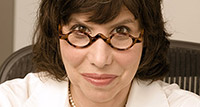
Dr. Alison Gopnik on the topic of
The Philosophical Baby: What Children’s Minds Tell Us About Truth, Love & the Meaning of Life

Dr. Robert Park on the topic of Superstition: Belief in the Age of Science

Dr. Alan Boss on the topic of
The Crowded Universe: The Search for Living Planets
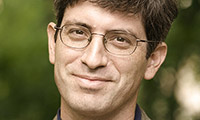
Carl Zimmer on the topic of H1N1
The Evolution of a Deadly Virus. What Diseases Tell Us About Evolution


